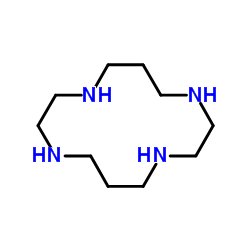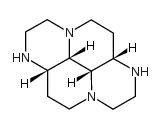Plerixafor (AMD3100)
Modify Date: 2025-08-23 15:32:33

Plerixafor (AMD3100) structure
|
Common Name | Plerixafor (AMD3100) | ||
|---|---|---|---|---|
| CAS Number | 110078-46-1 | Molecular Weight | 502.782 | |
| Density | 1.0±0.1 g/cm3 | Boiling Point | 657.5±55.0 °C at 760 mmHg | |
| Molecular Formula | C28H54N8 | Melting Point | 122-125°C | |
| MSDS | N/A | Flash Point | 361.8±26.2 °C | |
Use of Plerixafor (AMD3100)Plerixafor is a selective CXCR4 antagonist with an IC50 of 44 nM. |
| Name | Plerixafor |
|---|---|
| Synonym | More Synonyms |
| Description | Plerixafor is a selective CXCR4 antagonist with an IC50 of 44 nM. |
|---|---|
| Related Catalog | |
| Target |
125I-CXCL12-CXCR4:44 nM (IC50) |
| In Vitro | The CXCR4 inhibitor Plerixafor (AMD3100) is a potent inhibitor of CXCL12-mediated chemotaxis (IC50, 5.7 nM) with a potency slightly better than its affinity for CXCR4. Treating the cells with CCX771 or CXCL11 has no effect on CXCL12-mediated MOLT-4 or U937 TEM. In contrast, 10 μM Plerixafor inhibits CXCL12-mediated TEM in both cells lines[1]. Plerixafor (10 μM)-treated cells show a moderate reduction in cell proliferation compared to CXCL12-stimulated cells, which do not reach statistical significance[2]. |
| In Vivo | Plerixafor (2 mg/kg) administration to UUO mice exacerbates renal interstitial T cell infiltration, resulting in increased production of the pro-inflammatory cytokines IL-6 and IFN-γ and decreased expression of the anti-inflammatory cytokine IL-10[3]. Both perivascular and interstitial fibrosis are significantly reduced by the CXCR4 antagonist, Plerixafor (AMD3100) at 8 weeks[4]. LD50, mouse, SC: 16.3 mg/kg; LD50, rat, SC: >50 mg/kg; LD50, mouse and rat, IV injection: 5.2 mg/kg. |
| Cell Assay | U87MG cells are seeded in 96-well plates at the density of 6×103 cells in 200 μL/well and treated with CXCL12, Plerixafor or with peptide R. MTT (5 μg/mL) is added at each time point (24, 48, 72 h) during the final 2 h of treatment. After removing cell medium, 100 μL DMSO are added and optical densities measured at 595 nm with a LT-4000MS Microplate Reader. Measurements are made in triplicates from three independent experiments[2]. |
| Animal Admin | Mice[3] Male C57bl/6 mice (6-7 weeks old, weighing 20 g) are used. The animals are acclimated to the housing environment, which is SPF and had a temperature of 22°C and a 12h/12h light/dark cycle for a week. Then, they are randomly divided into following experimental groups, with 8 mice in each group: normal (no specific intervention), UUO+AMD3100 (mice received UUO surgery and 2 mg/kg AMD3100), and UUO+PBS (mice received UUO surgery and the same volume of PBS). AMD3100 and PBS are administered via intraperitoneal injection every day until sacrifice. Rats[4] The CXCR4 antagonist, AMD3100 dissolved in H2O, is delivered in the type 2 diabetic sand rat model at a dose of 6 mg/kg per day for 8 weeks. In complementary studies, the effect of CXCR4 antagonism (AMD3100 6mg/kg/d) on regulatory T cell numbers is examined. For these studies, AMD3100 or vehicle is delivered via minipump for a period of one week. |
| References |
| Density | 1.0±0.1 g/cm3 |
|---|---|
| Boiling Point | 657.5±55.0 °C at 760 mmHg |
| Melting Point | 122-125°C |
| Molecular Formula | C28H54N8 |
| Molecular Weight | 502.782 |
| Flash Point | 361.8±26.2 °C |
| Exact Mass | 502.447144 |
| PSA | 78.66000 |
| LogP | 0.20 |
| Vapour Pressure | 0.0±2.0 mmHg at 25°C |
| Index of Refraction | 1.492 |
| InChIKey | YIQPUIGJQJDJOS-UHFFFAOYSA-N |
| SMILES | c1cc(CN2CCCNCCNCCCNCC2)ccc1CN1CCCNCCNCCCNCC1 |
| Storage condition | Refrigerator |
| Hazard Codes | Xi |
|---|---|
| HS Code | 2933990090 |
| HS Code | 2933990090 |
|---|---|
| Summary | 2933990090. heterocyclic compounds with nitrogen hetero-atom(s) only. VAT:17.0%. Tax rebate rate:13.0%. . MFN tariff:6.5%. General tariff:20.0% |
| Plerixafor |
| Sdz sid 791 |
| 1,1'-[1,4-Phenylenebis(methylene)]bis(1,4,8,11-tetraazacyclotetradecane) |
| 1,4-Bis((1,4,8,11-tetraazacyclotetradecan-1-yl)methyl)benzene |
| 1,1'-[1,4-Phenylenebis(methylene)]bis[1,4,8,11-tetraazacyclotetradecane] |
| Mozobil |
| Unii-S915p5499n |
| 1,4,8,11-Tetraazacyclotetradecane, 1,1'-[1,4-phenylenebis(methylene)]bis- |
| AMD3100 |
 CAS#:623-24-5
CAS#:623-24-5 CAS#:295-37-4
CAS#:295-37-4 CAS#:439211-82-2
CAS#:439211-82-2 CAS#:74199-16-9
CAS#:74199-16-9![1-[4,8-bis(2,2,2-trifluoroacetyl)-1,4,8,11-tetrazacyclotetradec-1-yl]-2,2,2-trifluoroethanone Structure](https://image.chemsrc.com/caspic/398/406939-92-2.png) CAS#:406939-92-2
CAS#:406939-92-2 CAS#:80799-52-6
CAS#:80799-52-6 CAS#:170161-27-0
CAS#:170161-27-0
